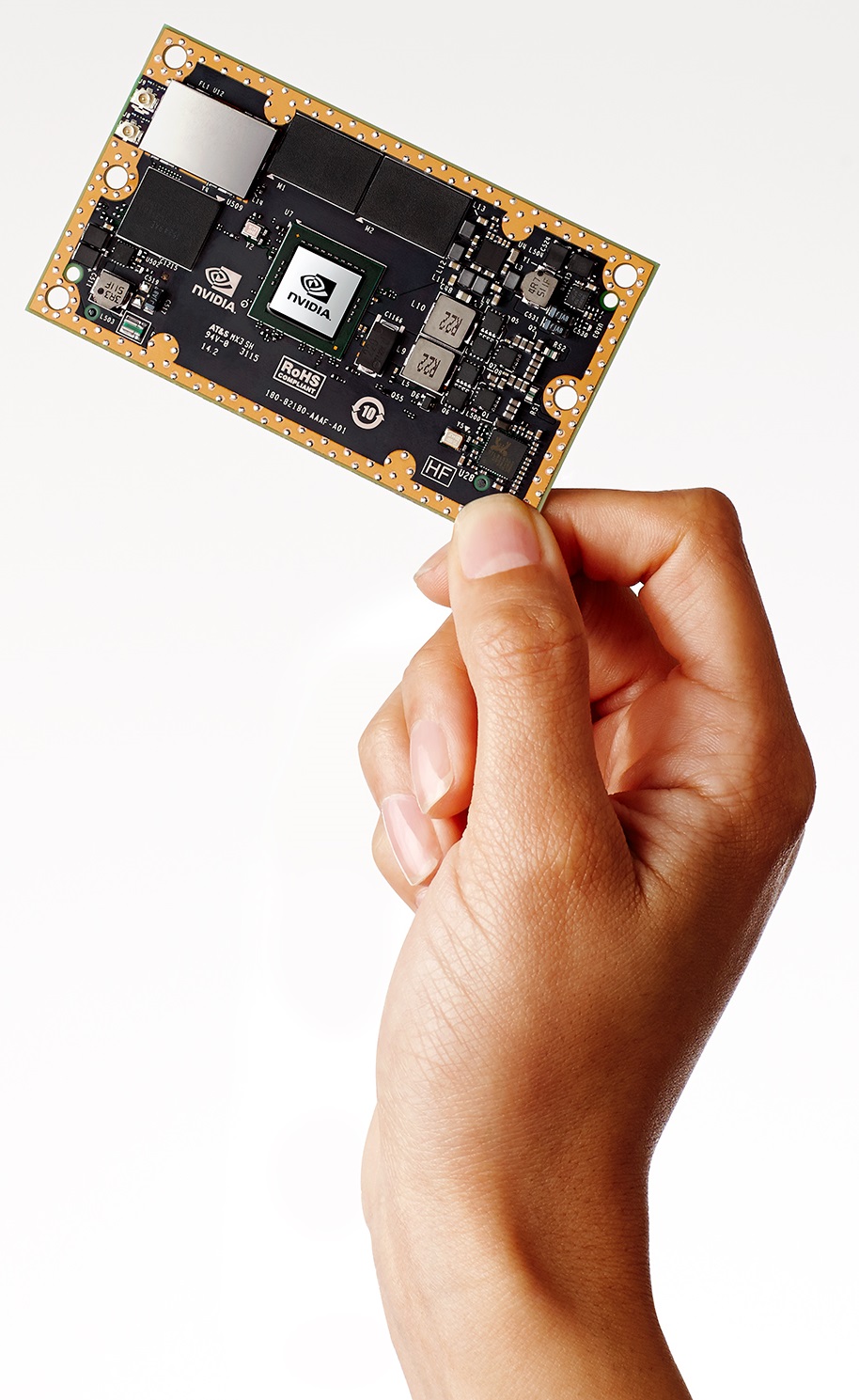Nvidia Adds Jetson TX1 To Its Deep Learning Roster

Earlier this year, Nvidia held its annual GPU Technology Conference, and this year was all about deep learning, with the then-new Titan X GPU, Digits DevBox, and the Drive PX system. It's continuing its lineup of deep learning products with a new device. However, this one is small and meant for the next wave of drones and robots. Meet the Jetson TX1 (say this sentence like The Jetsons theme song).
The Jetson TX1 is a "supercomputer on a module" the size of a credit card at 50 x 87 mm (LxW), with its main purpose being a platform for embedded visual computing. However, it can also perform other, more complex tasks such as finding its way across a room littered with furniture or discerning conversational speech.
| Nvidia Jetson TX1 | |
|---|---|
| CPU | 64-bit ARM A57 (number unknown) |
| GPU | 256-core Maxwell GPU (1 teraflop) |
| RAM | 4 GB LPDDR4 (25.6 Gbps) |
| Storage | 16 GB eMMC |
| Connection | 802.11ac, 2x2 Bluetooth, 1 GB Ethernet (networking) |
| OS | Linux for Tegra |
| Video | 4K video encoding and decoding |
| Camera | Supports 1400 megapixels per second |
The platform has some foundations based on the Tegra X1 SoC, with its GPU still using the 256-core Maxwell architecture. However, it uses only the 64-bit ARM A57 CPU as opposed to the Tegra X1's hybrid of four ARM A57 and four ARM A53 cores. Even with its large and complicated array of tasks, the entire module uses less than 10 W of power, Nvidia claimed.
On the software side, the Jetson TX1 supports the same libraries as Nvidia GPUs. This seems obvious, as cooperation from the rest of Nvidia's deep learning ecosystem yields more power to interpret data. The company gave the example of using the Digits DevBox as the source of an image. After the image is interpreted on the box, data is then sent to the TX1, where it can immediately classify the object when it "sees" the object in the real world.
Users will also have access to the cuDNN, or the CUDA Deep Neural Network library, which provides a database for inference and learning on the Jetson TX1 and Nvidia GPUs. The VisionWorks CUDA-accelerated API is also included. It will support OpenGL 4.5, Open GL ES 3.1, Vulkan, and other APIs and graphics drivers.
The base Jetson TX1 module is slated for an early 2016 release, priced at $299. However, there is also a Jetson TX1 Developer Kit, which features the device, a developer board and a 5MP camera. Interested parties can pre-order it on November 12 for $599, and it will ship on November 16 for U.S. customers, with international orders to follow on a later date.
______________________________________________________________________
Get Tom's Hardware's best news and in-depth reviews, straight to your inbox.

Rexly Peñaflorida II is a Contributor at Tom’s Hardware. He writes news on tech and hardware, but mostly focuses on gaming news. As a Chicagoan, he believes that deep dish pizza is real pizza and ketchup should never be on hot dogs. Ever. Also, Portillo’s is amazing.
Follow Rexly Peñaflorida II @Heirdeux. Follow us on Facebook, Google+, RSS, Twitter and YouTube .
-
Shankovich I've worked with enough UAV's to know this thing is way too expensive and power hungry to do most tasks needed. For civilian applications engineering (like me), something like an ARM only board is more than enough for flight controls, transmission, flight path recognition commands, and stability and control. I'm guessing they really want you to use those CUDA cores, but for anything flying, it's a bit overkill on power consumption. Can't complain about the size though, we'd have to see if the tradeoff between weight and power consumption pays off. $300 though..............Reply -
shloader A micro USB3 port would have been more universally leveraged vs a Gigabit port. Some might use a gig port during development but the option for an LTE radio could take it even further. At the rate we're seeing drone processing power advance, not to mention battery capacities, we'll probably start seeing drones with LTE radios on board so they can tour beyond WiFi range and report back anything they determine to be of interest to the operator in real time. Also so the operator can issue adjustments to the tour at greater range.Reply -
conrd6 Nvidia's product announcement for the Jetson TX1 dev kitReply
https://developer.nvidia.com/embedded/buy/jetson-tx1
shows an ARM A-57 CPU, but no camera, just a header for a camera. The whitepaper https://developer.nvidia.com/embedded/jetson/TX1/docs/jetson_tx1_whitepaper.pdf
shows performance capable of real time 30fps image classification (actually up ro 258 fps) at less that 6W power consumption. MIT students recently demonstrated that even the older/slower TK1 was capable of autonomous model car racing.
The documentation is way less developed than for the TK-1, but I'm ordering one anyway. By the time the documentation catches up, I will have figured out the basics of installation and workflow, and can start designing autonomous tractors/weeders.